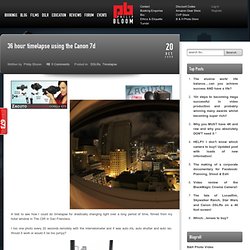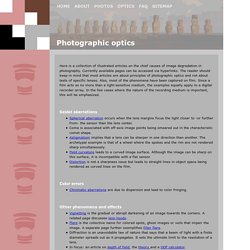

36 hour timelapse using the Canon 7d. A test to see how I could do timelapse for drastically changing light over a long period of time, filmed from my hotel window in The Clift in San Francisco.

I too one photo every 20 seconds remotely with the intervelometer and it was auto iris, auto shutter and auto iso. Would it work or would it be too jumpy? I think it works just fine, but in future I would have done just auto shutter as it would have done the same job for me and been cleaner at night. A good experiment and I learnt a lot from it. I will do another similar one soon with my new knowledge! Music is Ghosts by Nine Inch Nails. Shot using the Canon 7D, a Sigma 10mm fish eye and the Canon power supply for the 5dmkII/7D Check out my amazon store for the power supply, lens and intervalometer. 36 hour timelapse on the Canon 7D from Philip Bloom on Vimeo. Tutorial on how to turn your DSLRs stills timelapse into video. Check out this blog on how you set up the 7D or 5DmkII to actually take the stills.

But if your camera has an interval function like the Nikon D300, D700 etc this tutorial works exactly the same for you. Some compacts let you take interval stills too I believe but not sure which ones. Normally I would recommend using RAW mode to take your stills with but I used JPEGs for this tutorial for speed and to be honest the subject wasn’t that interesting, just shot out of my window at the Clift hotel in San Francisco using my 5dmkII and my 35mm F1.4 lens taking one photo every 7 seconds and the shutter was set to 1/20th and the ISO was 100. Lens was at f8. Purely used as a demonstration for doing post. Doing timelapse with the stills function gives you enormous flexibility and the ability to get some truly mind blowing low light timelapse sequences. How to make video timelapse from DSLR stills from Philip Bloom on Vimeo.
Easy Image Stabilizer For Any Camera - Photography Trick. Timelapse with a DSLR on Vimeo Video School. Timelapse on Vimeo Video School. G. Desroches - Cours photo - Photo de feux d'artifice. Photographier des feux d'artifice Pour le rendu des couleurs je trouve que les diapositives conviennent le mieux, avec une sensibilité de l'ordre de 100-200 iso.

Bien que les feux se déroulent la nuit, ce sont des spectacles extrêmement lumineux, aussi n'est-il pas nécessaire d'utiliser des pellicules plus sensibles. La principale difficulté consiste à mesurer la lumière car les posemètres ne sont que de faible utilité dans ces circonstances vu qu'ils sont trompés par l'obscurité ambiante (*). Il est donc évident que de nombreux essais s'imposent, en prenant des notes pour la fois prochaine; pour vous faire gagner un peu de temps, je vous livre ici mes propres observations pour un film de 100 iso. Suivant la distance à laquelle on se trouve, l'objectif sera de focale comprise entre 35 et 100 mm, le 50 mm étant généralement bien adapté.
L'ouverture la plus courante est de l'ordre de 8-11 et peut être de 16 pour les "bouquets" finaux (**) . [ Photo : W. Gérard Desroches. Photographic optics. Here is a collection of illustrated articles on the chief causes of image degradation in photography.

Currently available pages can be accessed via hyperlinks. The reader should keep in mind that most articles are about principles of photographic optics and not about tests of specific lenses. Also, most of the phenomena have been captured on film. Since a film acts as no more than a light-sensitive medium, the examples equally apply to a digital recorder array. In the few cases where the nature of the recording medium is important, this will be emphasized. Seidel aberrations Spherical aberration occurs when the lens margins focus the light closer to -or further from- the sensor than the lens center.Coma is associated with off-axis image points being smeared out in the characteristic comet shape.Astigmatism implies that a lens can be sharper in one direction than another.
Color errors Chromatic aberrations are due to dispersion and lead to color fringing. Other phenomena and effects Credits. Les filtres - Accessoire - Photo numérique. Digital Photography Tips: Digital Photography School. Apprendre à faire des photos et à les retoucher.